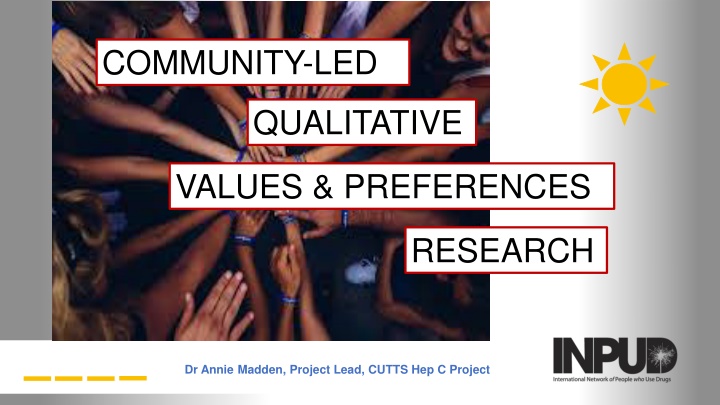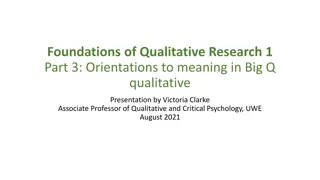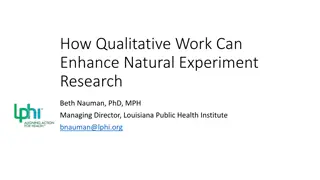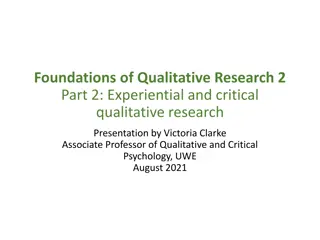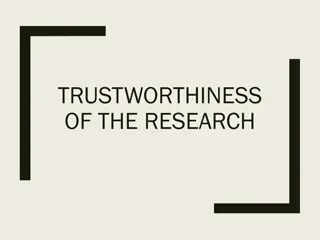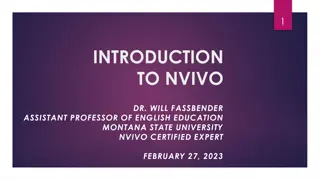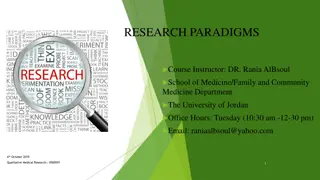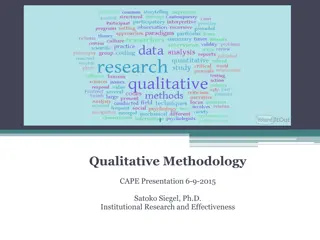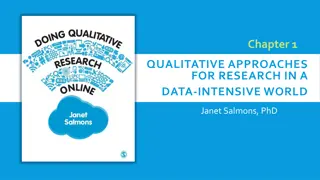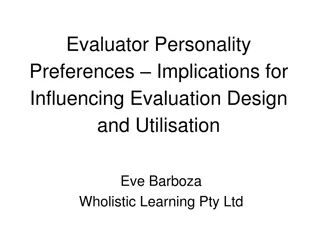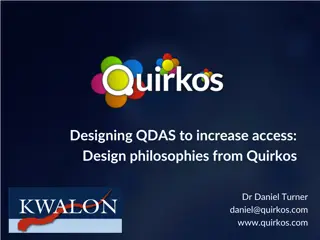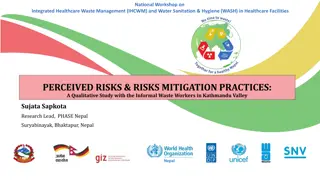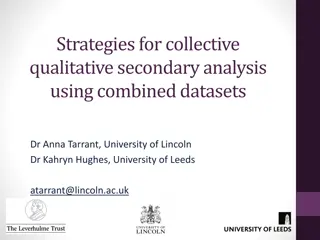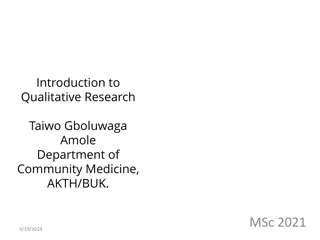Community-Led Qualitative Research on LDSS/N Distribution Preferences
Dr. Annie Madden leads a community-led research project focused on the values and preferences of people who inject drugs regarding LDSS/N distribution. The study aims to generate evidence on the feasibility and impact of implementing LDSS/N distribution programs, involving phases from pre-implementation to evaluation. Community involvement is crucial for understanding unique contexts and empowering community voices in shaping solutions. The methodology includes focus group discussions to evaluate community preferences and select products for piloting. This research emphasizes community empowerment, ensuring community expertise is central throughout the study process.
Download Presentation

Please find below an Image/Link to download the presentation.
The content on the website is provided AS IS for your information and personal use only. It may not be sold, licensed, or shared on other websites without obtaining consent from the author.If you encounter any issues during the download, it is possible that the publisher has removed the file from their server.
You are allowed to download the files provided on this website for personal or commercial use, subject to the condition that they are used lawfully. All files are the property of their respective owners.
The content on the website is provided AS IS for your information and personal use only. It may not be sold, licensed, or shared on other websites without obtaining consent from the author.
E N D
Presentation Transcript
COMMUNITY-LED QUALITATIVE VALUES & PREFERENCES RESEARCH Dr Annie Madden, Project Lead, CUTTS Hep C Project
LDSS/N Study Goal To generate evidence on the feasibility and impact of implementing programs for the distribution of LDSS/N to people who inject drugs. This evidence will inform global guidance and recommendations on LDSS/N.
Overall Study Design Phase 1 Pre-implementation of LDSS/N distribution Phase 2 Piloting of LDSS/N products Phase 3 Implementation of LDSS/N distribution program Pilot LDSS/N distribution LDSS/N distribution preferences Values & FGD.1 with PWID FGD.2 with PWID FGD.3 with PWID Evaluation of LDSS/N distribution BBS.1 NSP clients baseline BBS.2 NSP clients BBS.3 NSP clients PGM Routine NSP program data Process evaluation
Why Community-led Values & Preferences Research is important We already know what people who inject drugs think about LDSS/N from other research But every context is different and seemingly small differences can be very important. LDSS/N recommended by WHO since 2012 but are still not well use outside of HIC Due to lack of proper consultation with/listening to people who inject drugs in LMICs. Enter Community-led Values & Preference Research: Like other research, it can help us understand issues, people and contexts better But unlike most research, it is also fundamentally about community empowerment Community leading on the questions asked AND on the potential solutions Community being supported to speak their truth about what matters/what they value & why and how their preferences are shaped/re-shaped Community being involved in ALL stages of the research (as we are doing here) Not mere beneficiaries but experts in our own lives Leaders in knowledge generation that affects our lives.
Methodology Phase 1 Phase 1 Pre-implementation Phase Primary objective is to evaluate community values & preferences in relation to LDSS/N in the context of other harm reduction supplies available to people who inject drugs in 10 LMICs involved in the study. FGD 1 25 participants per site (some with multiple sites) small FGDs of 5 10 participants each duration 60-90 minutes facilitated by a trained community researcher and note taker (INPUD developing training) Participants will be people who inject drugs identified and recruited through word-of-mouth, community networks, peer educators, harm reduction workers, etc. During consultation, multiple brands/samples of LDSS/N of different sizes/volumes/gauges, and types (along with currently available & HDS products) will be shown, demonstrated, and then discussed to assess initial values and preferences. FGD will also focus on which products to pilot (if any) and the preferred model/approach for piloting various brands (i.e., how packaged or made available, etc.). FGD will also include discussion of knowledge mobilisation activities/IEC materials for pilot stage. Participants from FGD 1 will be invited to participate in Phase 2 pilot stage.
Methodology Phase 2 Phase 2 Pilot Phase Primary objective is to gather community preferences regarding proposed LDSS/N to confirm products for wider distribution in Phase 3. Participants from Phase 1 FGD who elect to participate in the pilot will be able to access selected LDSS/N via the usual NSP program (however that operates) for a 6-week period. Toward the end of the pilot period, pilot participants will be invited to a FGD 25 participants in each study site small FGD of 5-10 participants duration 60-90 minutes facilitated by trained community researcher and note taker. During FGD 2, participants will be asked about their experiences of using the piloted LDSS/N products and report their overall impressions from using the products and if they would use them in preference to other injecting equipment or not. Participants will be asked about the value of pilot knowledge mobilisation (IEC materials, etc), whether further materials/activities needed to support implementation phase.
Methodology Phase 3 Phase 3 Implementation Phase (approx. 18mths) Primary objective is to assess acceptability to community of the LDSS/N products distributed in Phase 3. The selected LDSS/N products will be available to all beneficiaries via the usual NSP program for the implementation period. Toward the end of the implementation period, beneficiaries will be invited to a FGD 25 participants in each study site small FGD of 5-10 participants duration 60-90 minutes facilitated by trained community researcher and note taker. During FGD 3, participants will be asked about their experiences of using the LDSS/N products and report their overall impressions from using the products and if they used them all the time, only sometimes, whether they continued using them and whether they would use them in preference to other injecting equipment if they were made available ongoing or not, etc. Participants will also be asked about the value of knowledge mobilisation (IEC materials, etc), whether further materials/activities would be needed to support ongoing availability.
